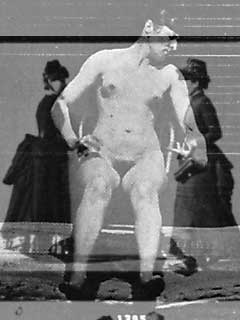
Denise Webber, still from Clay
Gilda Williams
What is a Photograph?
[...] So photography isn't necessarily a photograph any more, but
nobody's jaw is going to drop at this bit of postmodern 'news' – so
much for theory, in a way. The success of an exhibition like this, as
usual, lies in the strength of the work on show, and the Five Years
curating team of Morris, David Bate and Marc Hulson have to be
credited for bringing together this very fresh-looking gathering of
new London-based artists, but above all for bringing to the fore the
one show-stopping piece on exhibition: a video animation called
Clay, 1998, by Denise Webber.
Clay pretty much steals the show. Like the other works here, this
piece is modest in scale, screened as it is on an average, medium-sized
TV. Also like the other works, it is not meant to baffle the
viewer into puzzling over how it was made. Webber has quite
simply strung together consecutive series of stills from Eadweard
Muybridge's all-too-famous studies of human locomotion, restoring
time and space to these pre-cinematic sequences. This simple
operation, which has seemingly been begging to be done for over a
century in some form more gratifying than a home-made flipbook,
is the single, formidable idea behind Clay.
Like Frankenstein, these dead fragments are pieced together into
something weirdly alive, forced back into life from the annals of
photographic history and transformed into breathing, smirking,
moving beings. The results are extraordinary.
Webber has selected some lesser-known Muybridge photographs,
which make this video all the more unexpected. Suddenly the
figures turn from being mere case studies into thinking, smiling,
erotic beings. A man, dressed in his underwear, incongruously
handling a bayonet, is seen to break into an amused smile, perhaps
responding to the ludicrousness of the set-up. It's not that the scene
turns comical; rather the armed, semi-naked soldier regains his
dignity, demonstrates his understanding of his awkward position,
his good-natured accusation of the photographer's demands upon
him. In revealing this and so many other barely perceptible gestures,
Webber collapses the alleged objectivity of Muybridge's project
more effectively and pleasurably than a hundred cultural theorists
just talking about it.
These naked stills have always looked erotic; in motion, they are
borderline pornographic. You see Muybridge dwell on a bouncing
buttock, a flapping tit, and the eroticism of this observing, probing
man photographing a compliant naked woman in some isolated
courtyard is overwhelming. Jeff Wall, in analysing the traditional
painted picture, claimed that 'the painted body is the simultaneous
trace of two bodies' (the painter and his model), and as such is
inherently erotic. With Muybridge, and Webber's re-animation of
his work in Clay, we see that this tactile eroticism was obviously
still thriving at the dawn of modernity in these blatantly voyeuristic
studies of the human (and nakedly animalesque) body.
Above all it is the women in these pictures who are allowed to shed
their undignified anonymity and shine gloriously. Probably the
most unforgettable sequence is one fabulously sexy Victorian
woman, naked as usual, lounging brazenly under the overexposed
sun, taking a deep, pleasurable puff of a cigarette and then
stretching out her arm in triumphant, joyous abandon. The relaxed
fluidity of her motion, her lack of embarrassment at being naked,
her pre-suffragette feminism, are all delightful in a way that
Muybridge's mummified women had never been in the stills.
Webber's chosen soundtrack of ringing bells – a timeless sort of
sound and, as the artist points out, a sound that is public, like the
bodies on display – all enhance the sense of celebration in the
belated resurrection of these ghosts, who, until now, seemed only
the victims of voyeurism, art history and mean 19th-century science.
Clay is, in many ways, truly liberating.
Art Monthly no 219
Gilda Williams is an art critic and London correspondent for Artforum